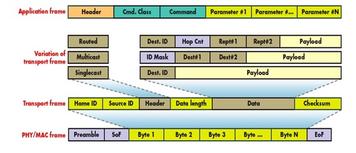Understanding Z-Wave MAC Layer and Frame Types
Advertisement
This page delves into the Z-Wave MAC layer, outlining the different MAC frame types used within a Z-Wave network.
The Z-Wave MAC layer performs several key functions:
- Unique Network ID (HomeID): Identifies a specific Z-Wave network.
- Network Size: Supports up to 232 nodes in a single network.
- Collision Avoidance: Employs an algorithm to prevent data collisions.
- Backoff Algorithm: Manages retransmission attempts after collisions.
- Reliable Data Transfer: Ensures reliable data delivery through automatic retransmission.
- Low-Power Operation: Supports energy-efficient operation through dedicated wakeup patterns.

Collision Avoidance
The MAC layer incorporates a collision avoidance mechanism that prevents nodes from transmitting simultaneously. This is achieved by having nodes remain in receive mode when they aren’t transmitting. If the MAC layer detects ongoing data transmission, it delays its own transmission. This collision avoidance is active on all node types whenever the radio is enabled.
Independence from RF Media
The MAC layer is independent of the specific RF media, frequency, and modulation method used. However, it requires access to either the frame data upon reception or the entire signal in binary form, whether as a decoded bit stream or a Manchester-coded bit stream. The transmission of a frame is delayed by a random number of milliseconds.
Data Stream
The data stream is Manchester coded and consists of a preamble, Start of Frame (SOF), frame data, and an End of Frame (EOF) symbol. The frame data is obtained from the transport layer at the transmitter and delivered to the transport layer at the receiver.
Z-Wave MAC Frame
Let’s examine the Z-Wave MAC frame. The Z-Wave MAC layer uses frame formats based on the channel configuration, specifically configurations 1, 2, and 3. Figure 1 illustrates the generic MAC frame format and the multicast frame format for channel configurations 1 and 2. For channel configuration 3, a ‘sequence number’ field (1 byte) is added after the ‘length’ field.
Channel configuration 1 supports a single channel (Ch. B), channel configuration 2 supports two channels (Ch. A and Ch. B), and channel configuration 3 supports three channels (Ch. A, Ch. B, and Ch. C).
Each MAC frame (MPDU) consists of the following components:
- MHR (MAC Header): Contains addresses, frame control information, and length details.
- MAC Payload: Contains the data specific to the frame type. Acknowledgement frames do not have a payload.
- MFR (MAC Footer): Contains the FCS (Frame Check Sequence).
Key Fields within the MAC Frame
- HomeID: A 4-byte field representing the unique network identifier. All nodes within a Z-Wave network share the same HomeID, which is assigned by the primary node during the inclusion process.
- Source Node ID: An 8-bit unique identifier for a node. Together with the HomeID, the NodeID identifies the originating node of a frame.
- Frame Control: A 16-bit field that contains information about the frame type, addressing, and other control flags. The Header type subfield within this field defines the frame type (single cast, multicast, ACK, routed frame, etc.).
- Length: A 1-byte field indicating the total length of the MPDU in bytes. A receiving node will not accept more bytes than the maximum length permitted for the current data rate.
- Sequence Number: A number provided by higher layers during transmission. The valid range is 0x00 to 0xFF.
- Destination Node ID: Used to address individual nodes. The following values are defined:
- 0x00 - (Uninitialized NodeID)
- 0x01 - 0xE8 (NodeID)
- 0xE9 - 0xFE (Reserved)
- 0xFF -(Broadcast NodeID)
- Data Payload: A variable-size field containing information specific to the individual frame. Acknowledgment frames do not include this field.
- FCS (Frame Check Sequence): An 8-bit checksum used to verify frame correctness at the receiver for R1 and R2 data rates. This error detection helps to identify erroneous frames and trigger retransmission within the Z-Wave network.
Multicast Frames
Multicast frames include a destination bit map.
Conclusion
Z-Wave MAC (Medium Access Control) layer frames play a crucial role in ensuring efficient and reliable communication within Z-Wave networks. As a fundamental part of the Z-Wave protocol, these frames facilitate device-to-device communication by managing data transmission, collision avoidance, and error detection. The MAC layer frames help maintain network integrity, optimize bandwidth usage, and support low-power operation—key features for home automation and IoT applications.
The structured design of Z-Wave MAC frames, including frame headers, payload, and CRC checks, ensures secure and interference-free communication. By enabling robust and energy-efficient communication, Z-Wave MAC layer frames significantly contribute to the protocol’s effectiveness in smart home ecosystems, making Z-Wave a preferred choice for reliable and scalable wireless control solutions.
Advertisement
 RF
RF

